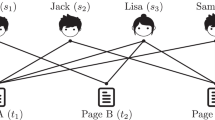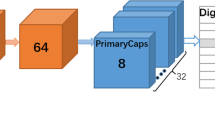Abstract
Achieving interpretable embedding of real network has a significant impact on network analysis tasks. However, majority of node embedding-based methods seldom consider the rationality and interpretability of node embedding. Although graph attention networks-based approaches have been employed to improve the interpretability of node embedding, they are implicitly specifying different weights to different nodes in a neighborhood. In this study, we present node embedding with capsule generation-embedding network(CapsGE), which is a novel capsule network-based network architecture, and uses node density based on the definition of uncertainty of node community belongings to explicitly assign different weights to different nodes in a neighborhood. In addition, this model uses the proposed cognitive reasoning mechanism for the weighted features to achieve rational and interpretable embedding of nodes. The performance of the method is assessed on node classification task. The experimental results demonstrate its advantages over other methods.











Similar content being viewed by others
References
Zhou J, Liu L, Wei W, Fan J (2022) Network representation learning: from preprocessing, feature extraction to node embedding. ACM Comput Surv 55(2):1–35
Palomares I, Porcel C, Pizzato L, Guy I, Herrera-Viedma E (2021) Reciprocal recommender systems: analysis of state-of-art literature, challenges and opportunities towards social recommendation. Inf Fusion 69:103–127
Wu Z, Pan S, Chen F, Long G, Zhang C, Philip SY (2020) A comprehensive survey on graph neural networks. IEEE Trans Neural Netw Learn Syst 32(1):4–24
Muzio G, O’Bray L, Borgwardt K (2021) Biological network analysis with deep learning. Brief Bioinform 22(2):1515–1530
Hoffman SC, Chenthamarakshan V, Wadhawan K, Chen PY, Das P (2022) Optimizing molecules using efficient queries from property evaluations. Nat Mach Intell 4(1):21–31
Wei W, Zhang Q, Liu L (2020) Bitcoin transaction forecasting with deep network representation learning. IEEE Trans Emerg Top Comput 9(3):1359–1371
Perozzi B, Al-Rfou R, Deepwalk Skiena S (2014) Online learning of social representation. Proceedings of the 20th ACM SIGKDD international conference on knowledge discovery and data mining. ACM, New York, pp 701–710
Grover A, Leskovec J (2016) Node2vec: scalable feature learning for networks. Proceedings of the 23rd ACM SIGKDD international conference on knowledge discovery and data mining, San Francisco. ACM, New York, pp 855–864
Ribeiro LFR, Saverese PHP, Figueiredo DR (2017) Struc2vec: Learning node representations from structural identit. Proceedings of the 23rd ACM SIGKDD international conference on knowledge discovery and data mining, Halifax, Canada. ACM, New York, pp 385–394
Huang X, Li J, Hu X (2017) Label informed attributed network embedding. Rroceedings of the tenth ACM international conference on web search and data mining, Cambridge, United Kingdom. ACM, New York, pp 731–739
Yang C, Liu Z, Zhao D, Sun M, Chang E (2015) Network representation learning with rich text information. Proceedings of the twenty-fourth international joint conference on artificial intelligence; Buenos Aires, Argentina. AAAI Press, Menlo Park, pp 2111–2117
Velikovi P, Cucurull G, Casanova A, Romero A, Lio P, Bengio Y (2018) Graph attention networks. In: Proceedings of the 6th International Conf. on Learning Representation (ICLR), Vancouver, Canada, pp 44–51
Xie L, Huang H, Du Q (2022) A hierarchical generative embedding model for influence maximization in attributed social networks. Appl Sci 12(3):1321
Yang Z, Cohen W, Salakhudinov R (2016) Revisiting semi-supervised learning with graph embedding. In: Proceedings of the 33nd International Conference on Machine Learning(ICML), New York City, NY, USA, pp 40–48
Defferrard M, Bresson X, Vandergheynst P (2016) Convolutional neural networks on graphs with fast localized spectral filtering. In: Advances in Neural Information Processing Systems 29: Annual Conference on Neural Information Processing Systems (NeurIPS), Barcelona, Spain, pp 3837–3845
Monti F, Boscaini D, Masci J, Rodola E, Svoboda J, Bronstein MM (2017) Geometric deep learning on graphs and manifolds using mixture model CNNS. Processing of the IEEE conference on computer vision and pattern recognition (CVPR). IEEE Computer Society, New York, pp 5115–5124
Li C, Wang S, Yang D, Li Z, Yang Y, Zhang X, Zhou J (2020) Graph attention auto-encoders. 32nd IEEE international conference on tools with artificial intelligence(ICTAI); Baltimore, USA. IEEE, New York, pp 163–179
Cai B, Zeng L, Wang Y, Li H, Hu Y (2019) Community detection method based on node density, degree centrality, and K-means clustering in complex network. Entropy 21(12):1145
Xu W, Yuan K, Li W, Ding W (2022) An emerging fuzzy feature selection method using composite entropy-based uncertainty measure and data distribution. IEEE Trans Emerg Top Comput Intell 1:1–13
Hinton GE, Krizhevsky A, Wang SD (2011) Transforming auto-encoders. Proceedings of the international conference on artificial neural networks. Springer, Berlin, pp 44–51
Patrick MK, Adekoya AF, Mighty AA, Edward BY (2022) Capsule networks-a survey. J King Saud Univ-Comput Inf Sci 34(1):1295–1310
Tang J, Qu M, Wang M, Zhang M, Yan J, Mei Q (2015) Line: large-scale information network embedding. Processing of the 24th international conference on world wide web, Florence, Italy. ACM, New York, pp 1067–1077
Li J, Zhu J, Zhang B (2016) Discriminative deep random walk for network classification. Proceedings of the 54th annual meeting of the association for computational linguistics, Berlin, Germany. The Association for Computer Linguistics, Berlin, pp 1004–1013
Chen J, Zhang Q, Huang X (2016) Incorporate group information to enhance network embedding. Rroceedings of the 25th ACM international on conference on information and knowledge management (CIKM), Indianapolis, USA. ACM, New York, pp 1901–1904
Li C, Li Z, Wang S, Yang Y, Zhang X, Zhou J (2017) Semi-supervised network embedding. Proceedings of the database systems for advanced applications-22nd international conference, Suzhou, China. Springer, Berlin, pp 131–147
Xu W, Li W (2016) Granular computing approach to two-way learning based on formal concept analysis in fuzzy datasets. IEEE Trans Cybern 46(2):366–379
Qiu J, Dong Y, Ma H, Li J, Wang K, Tang J (2018) Network embedding as matrix factorization: unifying deepwalk, line, pte, and node2vec. Proceedings of the 11th ACM international conference on web search and data mining; Marina Del Rey, CA, USA. ACM, New York, pp 459–467
Wang D, Cui P, Zhu W (2016) Structural deep network embedding. Proceedings of the 22nd ACM SIGKDD international conference on knowledge discovery and data mining. ACM, New York, pp 1225–1234
Cao S, Lu W, Xu Q (2016) Deep neural networks for learning graph representations. Proceedings of the13th AAAI conference on artificial intelligence; Phoenix, Arizona, USA. AAAI Press, Menlo Park, pp 1145–152
Wang C, Pan S, Long G, Zhu X, Jiang J (2017) Mgae: marginalized graph auto-encoder for graph clustering. In: Proceedings of the 2017 ACM on Conference on Information and Knowledge Management, pp 889–898
Kipf TN, Welling M (2017) Semi-supervised classification with graph convolutional networks. In: Proceedings of the 5th International Conference on Learning Representations (ICLR), Toulon, France, pp 1–14
Hamilton W, Ying Z, Leskovec J (2017) Inductive representation learning on large graphs. In: Proceedings of the Advances in Neural Information Processing Systems 30: Annual Conference on Neural Information Processing Systems (NeurIPS); Long Beach, USA, pp 1024–1034
Nguyen DQ, Nguyen TD, Phung DA (2020) A self-attention network based node embedding model. Proceedings of the machine learning and knowledge discovery in databases-european conference, Ghent, Belgium. Springer, Berlin, pp 364–377
Velickovic P, Fedus W, Hamilton WL, Li P, Bengio Y, Hjelm RD (2019) Deep graph infomax. ICLR (Poster) 2(3):4
Hasanzadeh A, Hajiramezanali E, Narayanan K, Duffield N, Zhou M, Qian X (2019) Semi-implicit graph variational auto-encoders. In: Proceedings of the Advances in Neural Information Processing Systems 32: Annual Conference on Neural Information Processing Systems (NeurIPS), Vancouver, BC, Canada, pp 10711–10722
Wang H, Wang J, Wang J, Zhao M, Zhang W, Zhang F, Guo M (2018) GraphGAN: graph representation learning with generative adversarial nets. Proceedings of the thirty-second AAAI conference on artificial intelligence, Louisiana, USA. AAAI Press, Menlo Park, pp 2508–2515
Wang H, Wang J, Wang J, Zhao M, Zhang W, Zhang F, Guo M (2019) Learning graph representation with generative adversarial nets. IEEE Trans Knowl Data Eng 33(8):3090–3103
Dai Q, Li Q, Tang J, Wang D (2018) Adversarial network embedding. Proceedings of the thirty-second AAAI conference on artificial intelligence; Louisiana, USA. AAAI Press, Menlo Park, pp 2167–2174
Zhu S, Li J, Peng H, Wang S, He L (2021) Adversarial directed graph embedding. Proceedings of the thirty-fifth AAAI conference on artificial intelligence. AAAI Press, Menlo Park, pp 4741–4748
Li W, Zhou H, Xu W, Wang XZ, Pedrycz W (2022) Interval dominance-based feature selection for interval-valued ordered data. IEEE Trans Neural Netw Learn Syst 1:1–15
Xu W, Yuan KY, Li W (2022) Dynamic updating approximations of local generalized multigranulation neighborhood rough set. Appl Intell 52(8):9148–9173
Goodfellow I, Pouget-Abadie J, Mirza M, Xu B, Warde-Farley B, Ozair S, Courville A, Bengio Y (2014) Adversarial directed graph embedding. In: Processing of the Advances in Neural Information Processing Systems 27: Annual Conference on Neural Information Processing Systems, Quebec, Canada, pp 2672–2680
Nguyen DQ, Nguyen TD, Nguyen DQ, Phung D (2020) A capsule network-based model for learning node embedding. Processing of the 29th ACM international conference on information and knowledge management; virtual event, Ireland. ACM, New York, pp 3313–3316
Manoharan JS (2021) Capsule network algorithm for performance optimization of text classification. J Soft Comput Paradigm (JSCP) 3(1):1–9
Goldani MH, Momtazi S, Safabakhsh R (2021) Detecting fake news with capsule neural networks. Appl Soft Comput 101:106991
Sabour S, Frosst N, Hinton GE (2017) Dynamic routing between capsules. In: Processing of the Advances in Neural Information Processing Systems 30: Annual Conference on Neural Information Processing Systems (NeurIPS); Long Beach, USA, pp 3856–3866
Hinton GE, Sabour S, Frosst N (2018) Matrix capsules with EM routing. In: Proceedings of the 6th International Conference on Learning Representations(ICLR); Vancouver, BC, Canada, pp 1–15
Sen P, Namata G, Bilgic M, Getoor L, Galligher B, Eliassi-Rad T (2008) Collective classification in network data. AI Mag 19(3):93–93
Jean S, Cho K, Memisevic R, Bengio Y (2015) On using very large target vocabulary for neural machine translation. Assoc Comput Linguist (ACL) 1(1):1–10
Van der Maaten L, Hinton GE (2008) Visualizing data using t-SNE. J Mach Learn Res 9(11):2580–2605
Funding
This research was supported by Hebei Natural Science Foundation (F2021205014), funded by Science and Technology Project of Hebei Education Department (ZD2022139), supported by the Central Guidance on Local Science and Technology Development Fund of Hebei Province (226Z1808G), funded by The Introduction of Overseas Students in Hebei Province (C20200340).
Author information
Authors and Affiliations
Corresponding author
Additional information
Publisher's Note
Springer Nature remains neutral with regard to jurisdictional claims in published maps and institutional affiliations.
Rights and permissions
Springer Nature or its licensor (e.g. a society or other partner) holds exclusive rights to this article under a publishing agreement with the author(s) or other rightsholder(s); author self-archiving of the accepted manuscript version of this article is solely governed by the terms of such publishing agreement and applicable law.
About this article
Cite this article
Wang, J., Zhang, D., Wei, J. et al. Node embedding with capsule generation-embedding network. Int. J. Mach. Learn. & Cyber. 14, 2511–2528 (2023). https://doi.org/10.1007/s13042-023-01779-9
Received:
Accepted:
Published:
Issue Date:
DOI: https://doi.org/10.1007/s13042-023-01779-9




